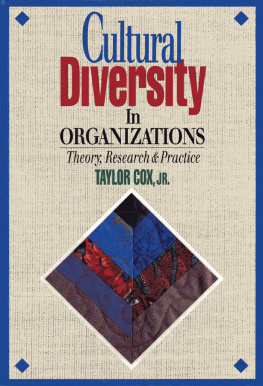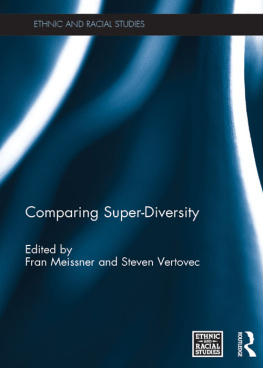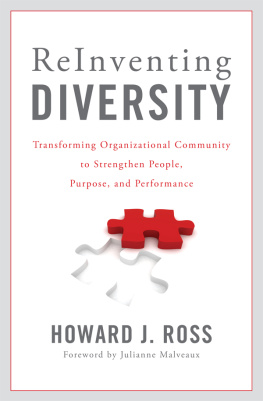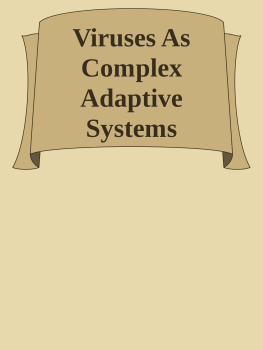DIVERSITY
AND COMPLEXITY
PRIMERS IN COMPLEX SYSTEMS
Ant Encounters: Interaction Networks and Colony Behavior,
by Deborah M. Gordon
Diversity and Complexity, by Scott E. Page
DIVERSITY
AND COMPLEXITY
Scott E. Page

Copyright 2011 by Princeton University Press
Requests for permission to reproduce material from this work should
be sent to Permissions,
Princeton University Press
Published by Princeton University Press,
41 William Street, Princeton, New Jersey 08540
In the United Kingdom: Princeton University Press,
6 Oxford Street, Woodstock, Oxfordshire OX20 1TW
All Rights Reserved
ISBN (pbk.) 978-0-691-13767-4
Library of Congress Control Number: 2010936220
British Library Cataloging-in-Publication Data is available
This book has been composed in Adobe Garamond and Helvetica neue
Printed on acid-free paper.
press.princeton.edu
Typeset by S R Nova Pvt Ltd, Bangalore, India
Printed in the United States of America
1 3 5 7 9 10 8 6 4 2
TO STAN REITER AND CARL SIMON
Two bright shining lights that havent always
pointed in the same direction.
For that I am ever grateful.
CONTENTS
ACKNOWLEDGMENTS
I have many people and places to thank for their assistance with my efforts on this book. A decision by the Santa Fe Institute and Princeton University Press to create a series of books demonstrating the advances in the science of complexity was the impetus for this particular book. Elementary physics informs us that a slight push can have a large effect provided that the object sits atop a big hill. For me, that hill (literally) was a year spent at the Center for Advanced Studies in the Behavioral Sciences at Stanford. The center afforded me the time and space needed to complete a rough draft. My return to the University of Michigan provided a yearlong author meets critics session that improved the text that follows. A USAF MURI grant and NSF IGERT and HSD grants provided funding to allow me to workshop portions of the text as well.
In researching this book, I gained renewed respect for the scholarship of many people, most notably, Simon Levin, Steven Frank, Rick Riolo, David Krakauer, Jenna Bednar, Bobbi Low, Melanie Mitchell, and Martin Weitzman. A book of this scope demands broad strokes and limited detail. Many times, I felt as though I stood before a paint by numbers canvas holding a spray gun. One cannot help but feel ones own sweeping attempt to contribute to be inadequate by comparison with the detailed care with which these scholars approach questions.
I wish to especially thank John Miller, whose vision inspired this series, and Chuck Myers, for cracking the whip and editing the text. Without Chuck, this project might not have been finished until May 2014. Throughout the writing, Howard Oishi and Mita Gibson prevented me from spiraling into an administrative abyss. Without the suggestions, critiques, and ideas of many friends and colleagues whove contributed to this project, I doubt Id have finished it. Simon Levin, Rajiv Sethi, Bill Clark, Sarah Cherng, Jenna Bednar, and P. J. Lamberson commented on earlier drafts of this book and found some glaring errors in fact and logic. Andrea Jones-Rooy worked through the entire text and relieved the reader of twenty-seven and a half tedious paragraphs and two hundred and sixteen unnecessary flowery adjectives. Evan Economo gave a near final draft a thorough reading and identified no fewer than eleven places where I would have offended natural scientists. Thanks to all.
Ive dedicated this book to a diverse, complex pair of muses: Stan Reiter and Carl Simon. Over the years, Stan and Carl, along with their partners Nina and Bobbi, have offered guidance, wisdom, patience, and love to me and to my family.
To Orrie and Cooper, my constant reminders of the complexity that diversity can produce, I marvel at your abilities to find and produce joy. And to Jenna, as our continuous lives increase in dimensionality and depth, you remain the helium in my balloons, the peach in my cobbler, and the warm home at the end of the prairies winding path.
DIVERSITY
AND COMPLEXITY
PRELUDE: THE MEANING OF DIVERSITY
The diversity of the phenomena of nature is so great, and
the treasures hidden in the heavens so rich, precisely in
order that the human mind shall never be lacking
in fresh nourishment.
JOHANNES KEPLER
In writing this book, I have been fortunate to be guided and motivated by the efforts of an incredible collection of scholars. The study of diversity and complexity attracts a vast array of scholars from multiple disciplines whose passion, intelligence, and energy inspire awe. In what follows, I attempt to pull together ideas, concepts, models, and results that intersect with the topics of diversity and complexity, and to make sense of research from multiple disciplines. It proves a daunting, humbling, and ultimately, exciting task.
The book combines illustrative examples, formal models, and bits of data to produce an overview of the interplay between diversity and complexity. The relationship between the two is not always easy to understand. Diversity and complexity lie at the core of many of the challenges that we currently face: managing ecosystems, organizations, and economies. Progress in these domains or, more modestly, continued survival can only benefit from a more nuanced understanding of diversity in complex systems, and that requires naming the parts and learning how those parts combine. It means that we must go beyond stories and analogies. We have to test intuitions and metaphors against logic and empirical reality. For example, its not enough to say diversity enhances robustness. If we are to take intelligent action, we need to define our terms preciselywhat is diversity? and what is robustness?
For those people who feel diversity to be of paramount importance for the continued flourishing of societies, economies, and ecosystems, I hope that this book provides theoretical foundations to support that passion. A warning though: the book challenges the nave assumption that we should always prefer more diversity to less. Too much diversity, as I show in several places, can produce catastrophe or inefficiency. Rotating the presidency of the European Council between a few countries has advantages. Leadership diversity produces innovative policies and prevents the concentration of power. Rotating it among dozens of countries, though, may create policy instability (Kollman 2003). Even if on balance diversitys a good thing, we can have too much of it.
For those people who do deep scientific work within a particular discipline, accept my apologies that this book covers a lot of territory that you already know. But it will also, I hope, introduce a few new measures, concepts, models, and theories from other disciplines that spark new ideas. Working across the disciplines requires translating formal language (one persons epistatic interaction is another persons externality or spillover), suffering through notational conventions, and learning implicit assumptions. My not so secret hope is that this book introduces some ideas that jump the silo of their home discipline and advance interdisciplinary science.
The title of this prelude, the meaning of diversity, should evoke three interpretations: importance, essence, and averaging. The importance of diversity in complex systems is the central theme of this book. Why does diversity matter? What roles does it play? I show that diversity has many roles and effects. Diversity can provide insurance, improve productivity, spur innovation, enhance robustness, produce collective knowledge, and, perhaps most important in light of these other effects, sustain further diversity. But diversity, for all its benefits, is no panacea: It can contribute to collapse, conflict, and incomprehensible mangles.
Next page






